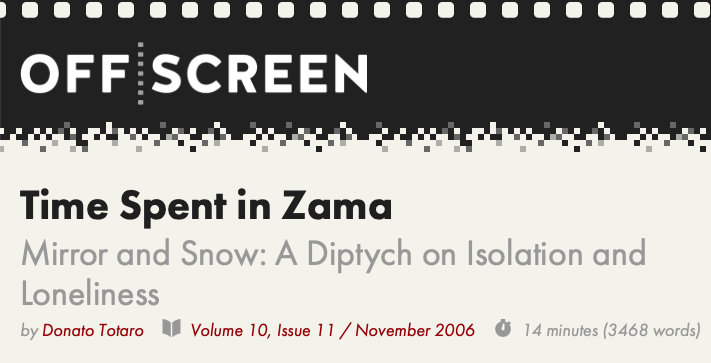
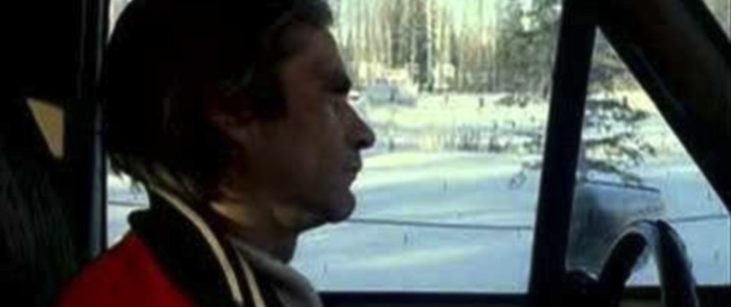
Although there was no snow on the ground at the end of October (thankfully!) during the 2006 Festival of New Cinema (Oct. 18-28), there was plenty of the white stuff on display in the Canadian film Snow, one of my favourite films at this year’s Festival. Snow, directed by Turkish-born, Canadian-raised, and current American citizen Hakan Sahin, is an intelligent exploration of the psychological effects of living in geographically remote areas far from urban centers. Snow is Sahin’s second feature film, following Mirror, which also played at this festival several years ago. On December 9, 2005 the Turkish daily newspaper wrote about Hakan Sahin winning a prize for Snow at the Belfort Film Festival in France:
Born in Ünye, Turkey, in 1965, Sahin immigrated to Canada with his family when he was 15 years old.
At the age of 25 he graduated from the University of Alberta in Edmonton with a bachelor of science degree in computer engineering. He joined his brother in a small family trucking business operating out of the remote oil-field hamlet of Zama in northern Alberta. He worked there for the next five years as a truck driver.
As he reiterated in Montreal during his introduction to the film at the 2006 FNC, the years of living in the remote region of Zama was an inspiration in making Snow; as well as his first feature film, Mirror, which was also shot in Zama and is in many respects a run through for Snow. Both Snow and (less so) Mirror are designed as mood pieces structured around the idea of ‘cabin fever,’ what living in deep isolation does to one’s state of mind, and consequently one’s sense of perception. The central character Loeffen (played by Lambert Loeffen) works at an oil field in Alberta, Canada 150 miles from the nearest settlement or town, Zama City. Zama City is located in the Northwest Corner of the Province of Alberta, roughly 900 kilometres (560 miles) north of Edmonton. Loeffen’s days revolve around work, which includes, when he is lucky, day trips to Zama to purchase work supplies. There is not much of a plot in Snow, just a sequence of scenes following Loeffen as he gets his work order, drives to Zama and seeks some companionship and diversion. Although the potential for diversion might not seem great in Zama –a diner, a convenience store and the odd ‘party’ at the town hall– Loeffen looks forward to his trips to Zama. The film details such a day.
Loeffen’s constant companion is his dog, appropriately named Blackie. Nowhere is the adage “a dog is a man’s best friend” more apt than in Snow. The viewer gets the sense that if Loeffen did not have Blackie for company he would go completely stir crazy. Instead he only seem to go half stir crazy, clinging to the practicalities of the daily work routine, while slipping into subjective states of mild hallucinations during off-work moments of boredom, depression, and loneliness.
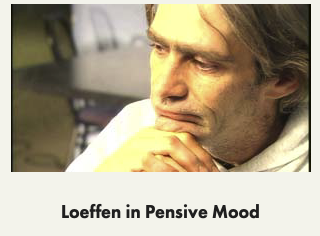
The film’s subtle evocation of Loeffen’s incursions into dream-like states is greatly aided by composer Masami Tomihisa’s ambient music, Terry Tran’s sound and Shawn Pinchbeck’s sound design, which adds a distinctly non-realist tone to the film’s deliberate rhythmical editing between scenes of human interaction and moments of isolation. The film is especially effective in capturing how the experience of time bends and mutates when in isolation. Sahin achieves this temporal estrangement in several ways; for example, by changing film speeds and film stock (digital video/35mm film), by the non-linear editing, by the repetition of events/scenes, by moments of silence and blackness, and by the ambiguity of spaces revisited: are space revisited or are we simply seeing the same spatial event over again? Although there are a few events which are repeated or revisited, there is one key ‘repeated’ event. The scene first occurs early in the film. Loeffen is driving in his pickup truck at night along a dark, snowy road, with his trusty dog seated next to him. Something abruptly appears on the road ahead. Shaky, step printed point of view shots render a partial view of car head lights, or the moon lit eyes of a deer. Loeffen veers his truck off the road into a snow embankment. A surprised Loeffen exclaims to Blackie: “What the hell was that?” When the scene occurs a second time, with very little (if any) variation, the viewer is puzzled, but may concede that with such conditions (no street lights, slippery roads, etc.) perhaps Loeffen did drive off the road a second time. When it occurs a third time, however, we realize that reality is no longer what it seems (Loeffen’s retort of “What the hell was that?” should be “When the hell was that?”).
The last time this repeated scene occurs leads to the film’s enigmatic final scenes. With his car stranded, Loeffen and his dog walk off in search of help. Loeffen builds a fire for warmth. While the fire burns, the smouldering flames flicker off into the night sky. As the camera tilts to follow them the image turns to slow motion. The visual effect of the red flames burning and streaking against the dark night background recalls a Norman McLaren hand painted or scratched-on film.
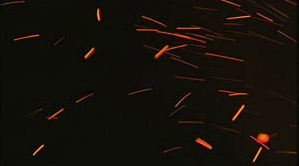
Continuing their walk, Loeffen comes across a small cabin with a warm, welcoming light shining within. Loeffen first knocks on the door, and when no one responds, opens the unlocked door and enters into the cosy confines of a lived-in cabin, with an inviting fire burning in an old wood oven. Loeffen maintains a running conversation with Blackie, wondering who might live in the cabin and whether they would be angry to find him inside. Loeffen’s queries are answered when a large Native looking man enters the cabin (the actor is Serbian, Ljubo Bakic). Loeffen excuses himself for entering the cabin without permission, but the stranger replies with unsettling kindness: “No need to apologize. I was kinda expecting you anyway. I just had a hunch. That’s why I left the cabin, to go look for you.” Much of their conversation resonates with import, such as the casual line delivered by the stranger, “It’s hard to tell what’s real and what isn’t after you’ve been out here a long time,” a clue to the viewer to question appearance and reality. He invites Loeffen to a fresh wine-fried steak and they continue talking and drinking wine. One of my favourite lines comes near the end of this cabin scene, when Loeffen talks to Blackie about the stranger while he has slipped out of the cabin for the steak: “I’m kind of nervous..is he being nice or is he being weird!”
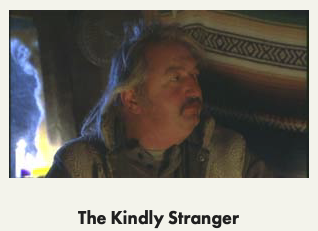
The stranger opens up to Loeffen with the story of how he lost his son in the woods when he was called upon to search for some firewood. It becomes apparent that the two strangers are kindred spirits, both tinged by the melancholia of loneliness and isolation. After the sad story the scene cuts to the exterior of the cabin and then to a gorgeous pixillated night sky shot which represents a transition to morning.
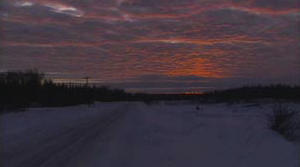
The camera then cuts to an exterior long shot of front of the cabin. Loeffen exits the cabin into the fresh morning air. The camera cuts back to the inside of the cabin, showing us a sequence of close-up shots: a rusted oven, a hanging bunch of tattered old socks, an unused cup, an oil lamp, a dirt filled floor. The cabin now looks as if it has been abandoned for years. The stranger is nowhere to be seen. Loeffen seems nonplussed by the bizarre and unexplainable event which has just transpired. We can make what we will of this scene: Was this Loeffen’s dream or hallucination? Or a fantasy nurtured by his desire for human companion? Or did Loeffen have a brief encounter with a ghost? Loeffen walks away from the cabin. The scene cuts to the camera in the woods, with Loeffen on frame left in long shot walking toward the foreground. The whole left side of the frame seems oddly distorted, as if a mirror image. Before we can reorient our perceptual focus, a ‘second’ Loeffen enters the right frame in foreground, staring at his ‘other’ image. Surprised by this oddly metaphysical confrontation, Loeffen turns to look back at the off-screen cabin, as if it contains an answer to the mystery. The image freeze frames and the film ends.

This cabin scene, especially if one reads the stranger as a phantom, reminded me of the great Japanese Feudal period ghost film Ugestu, and the scene where the potter Genjuro returns home to the wife he left years earlier. In both cases a character is unknowingly co-existing with a ghost-like character, and the revelation of this comes to the viewer (in Snow) and character (in Ugetsu) through a transformation in living space from cosy and lived-in to decrepit and abandoned. The scene in question occurs at exactly the same point in the narrative as in Snow, as the penultimate scene. After a series of life changing experiences Genjuro decides to return home to his former village life. However, he does not know that his wife was murdered during his absence, a casualty of a Civil War. When he arrives home he calls out for his wife, Miyagi. The camera pans right with Genjuro to reveal an abandoned, empty house. Genjuro exits through the back door and turns back in the direction of the front door. As the camera pans right to follow Genjuro, visible through an open window, the camera surprisingly reveals a lit candle on the extreme right corner of the frame which was not there moments earlier. Then, in the same continuous movement, we see Miyagi seated and cooking at the hearth, which moments earlier lay unused and unattended. Genjuro’s happiness at seeing Miyagi overwhelms his own common sense, which would surely have him wondering how he could have missed Miyagi the first time around. Genjuro spends the night with his wife, and gently falls asleep with Miyagi tending to his every need. Genjuro awakens the next morning (as does Loeffen) alone. As he searches for Miyagi the village elder arrives to inform him that his wife died long ago. Genjuro moves through the empty, abandoned house, and slowly comes to realize that the being he had spent the evening with was a ghost (or his phantasy projection).
In both cases Loeffen and Genjuro share quiet and personal moments with characters that are not ‘real.’ And likewise the ephemeral characters, the stranger and Miyagi, are kind and accommodating.
Another quality shared by both films is the use of landscape/nature and lived objects to transmit both the passage of time and the sense of melancholia experienced by both characters (Loeffen and Genjuro). Japanese art and aesthetics has a word to express this feeling: “sabi.” Two definitions place the term sabi in an historical and artistic context that relates to both Ugetsu and Snow: Firstly,
Sabi was a very old word, found as far back as the Manyoshu where it has the meaning of “to be desolate.” It later acquired the meaning of “to grow old” and is related to the word “to grow rusty.” 1
In the second quote Japanese scholar Makoto Ueda discusses sabi in relation to the famous Haiku poet Matsuo Basho (1644-1694):
Sabi is perhaps best known of all these ideas pertaining to Basho’s poetics. Basho, however, seldom used that term himself, although he often used the word sabishi from which it was derived. Sabishi primarily means solitary or lonely, referring to a man’s state of mind when he is in want of company. But Basho seems to have used that word in a more limited sense. Here is, for instance, Basho’s Haiku using the word sabishi:
Loneliness
Standing amid the blossoms,
A cypress tree
…In this poem, then, loneliness is not referring to a man’s personal emotion; it is describing an impersonal atmosphere, a mood created by a natural landscape.
….There is only one poet remaining today that Basho reportedly said had sabi, and this quality of loneliness is manifest is [sic] that poem, too. In fact, that poem is strikingly
close to the cypress poem just cited:
Under the blossoms
Two aged watchmen,
With their white heads together
….Lovely as the blossoms are, they must eventually fall with the passing of time, as suggested by the white hair of the watchmen…they are part of impersonal nature. Such seems to be the implication of sabi, the lonely mood latent in this sort of natural scenery. 2
This feeling of “impersonal nature” and the loneliness of “man’s state of mind when he is in want of company” accurately reflects Snow’s treatment of nature and of Loeffen’s (and the stranger’s) state of mind. The sequence of close-ups in the cabin in its present state –the rusted oven, the old sock, the old oil lamp, the upturned cup, the debris– represent the many meanings of sabi: the ‘weatheredness’ of time passed and the stranger’s sense of loss and loneliness. When Loeffen confronts his own image in the film’s final shot it is within the “impersonal nature” of a wintry wooded setting. Likewise, as the stranger recounted in his tragic story, his son died when he became lost in the frigid woods (“impersonal nature”) in search of firewood.
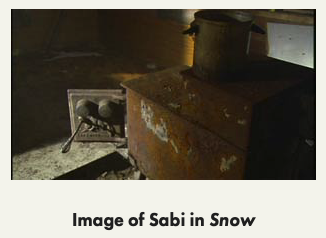
The incorporation of poetry above is fitting, since Snow and Mirror take as their inspiration a “poem on loneliness” by the Turkish poet Orhan Veli (quoted at the film’s closing credits):
They don’t know-
Those who don’t live alone.
How fearful that silence is.
How we talk to ourselves.
And how we run to the mirror,
Longing for a soul.
They don’t know.
The final shot of the film also reminds me of a parable cited by the Iranian director Mohsen Makhmalbaf in a piece he wrote called “Mirror Images.” In the piece Makhmalbaf quotes a famous Iranian parable: “There is a parable that the fact was a mirror in God’s hand but it broke. People picked up the broken pieces and each one saw his reflection in it, each thought that he had held the fact, that he alone knew the reality.” 3 This parable, a Middle Eastern version of Plato’s “The Cave,” also sheds some light on the final shot of Snow. Coming out of the surreal meeting with the stranger in the cabin, Loeffen (and the viewer) can no longer trust what he sees. Reality has become an illusion. Echoing the Turkish poet Veli, Loeffen “runs to the mirror…longing for a soul,” but this encounter with his mirrored self is also a reminder that as long as he lives “in the state of mind of Zama,” he can not ‘know reality.’ What he sees around him, like the deer on the road, the stranger in the cabin, the self-reflection in the woods, are like the ‘broken pieces’ of the mirror.
While all the above may make Snow seem solemn, there are, in fact, some brilliantly understated moments of comedy in Snow, such as the scene in the convenient store where two elderly men are seated at a table drinking coffee, while Loeffen purchases a gift. One man complains of a sore back and the other offers his home remedy: “Piss on two hot bricks, inhale the fumes, clear it up for ever.” The man with the sore back replies, “That sounds more like a cure for a cold.” A sense of comic ‘Zama’ ennui is nicely captured in the well-written scene between Loeffen and two young women (teenagers perhaps) he meets at the Saturday night dance. They end up back at one of their apartments, but where most films would use this as an opportunity to inject some romance, sex, or plain spice, the three just spend the evening making ridiculously banal conversation (‘real dialogue’ rather than movie talk), smoking dope, and listening to a romantic pop tune in stone silence. Just to underscore the point, Sahin intercuts the conversation with shots of a television set tuned to off-air station static. As they sit listening to the pop song the scene ends with a fade to black. The song bridges the next shot, a close-up of Loeffen’s forlorn looking dog Blackie seated in the front seat of Loeffen’s truck, as if to punctuate who Loeffen’s real soul mate is.
In many respects Snow is a (if you excuse me this pun) “mirror” image of Sahin’s first film, Mirror. Both films are about central characters dealing with the emotional and psychological effects of living in geographical isolation; both films reference the same Orhan Veli poem (Mirror in the beginning, Snow at the end), use the same locations (Zama and specific places in Zama, like the cabin), feature actual residents of Zama as secondary characters and some of the same actors in principal roles (Catherine Mazer, Ljubo Bakic and Lambert Loeffen), and end with mirror reflections in the woods. There are, however, also several differences between them. Mirror has far more quirky humour than Snow, and takes place in the summer rather than winter. Mirror is less spatially ‘closed’ off than Snow because it contains flashbacks to places outside Zama and gives more background story to the central character, an older graduate student (played by Ugur Polat) at the University of Alberta who takes up a job in Zama during the summer to make some money and to seek solitude for rest and research. Mirror is also less visually stylized than Snow. Where in Snow it is (mainly) the visual and aural touches of character (Loeffen) subjectivity that underscores the theme of isolation and loneliness, in Mirror the same theme is suggested through story and narrative action. For example, the film is filled with moments and incidents of captivity/containment: a squirrel trapped in a box, a car trapped in a ditch, a car trapped up in a tree, a fly trapped under a finger and a stick, a hamster taken into a child’s mouth (voluntarily!), a shot glass taken whole into a mouth, and a Cocteauesque film (shot by Sahin) seen by the student on television in which a man is trapped in his room.
However, the most important difference between the two films is that the character in Snow is an ‘insider,’ someone who has lived in/around Zama 4 while the central character in Mirror is an ‘outsider,’ a young man of Turkish descent who takes a job working at the convenience store in Zama with the belief that it will leave him ample free time to work on his dissertation. Instead he falls into a state of depression, spurred on by a memory which he is unable to leave behind: the death of his brother by drowning. This can in fact be seen as the central theme of Mirror: that you can not escape your memories, no matter how far you travel in trying. As an ‘outsider’ the student is culturally alienated inZama in two senses. For starters, the student is culturally alienated as a Turkish man in Canada who feels it is necessary to hang on to his cultural identity. This point is brought out in an involved discussion the student has with a truck driver of East European (Serbian) descent, Sonny (Ljubo Bakic, who plays the stranger in Snow), who feels one must simplify their life by assimilating wholeheartedly into the ‘new’ world. Sonny’s philosophy of life is “not to think but to life,” something which the student is unable to do. The student is doubly alienated as an intellectual (he is studying philosophy) in a community of blue collar workers. Hence his feeling of cultural alienation is only exacerbated by the loneliness caused by geographical isolation. Which is why Mirror and Snow work so well seen together, as they form a powerful diptych on the varying moods and tones of loneliness, alienation, and melancholia.
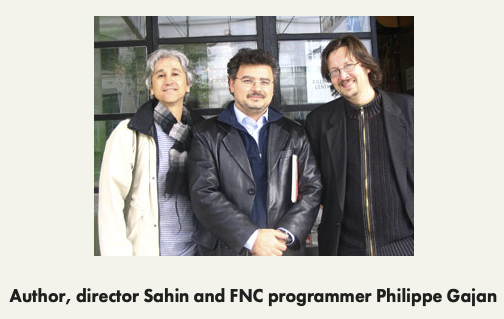
Notes
- Murasakki Shikibu, “On the Art of the Novel”, ed. WM. Theodore de Bary, in Japanese Aesthetics and Culture, Nancy G. Hume, ed., Albany: State University of New York Press, 1995, 53.
- Makoto Ueda, “Basho on the Art of the Haiku: Impersonality in Poetry”, in Japanese Aesthetics and Culture, Nancy G. Hume, ed., Albany: State University of New York Press, 1995, 154-155.
- Cinemaya, no. 13 (Autumn 1991): 19.
- In Mirror Lambert Loeffen, playing a character named Burnt, tells the student that he has lived in Zama for over 20 years.
